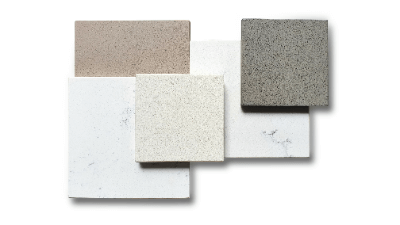What Is Quartzite?
 Quartzite is an artificial stone made of crushed natural quartz or quartz bound and molded with resin.
Quartzite is an artificial stone made of crushed natural quartz or quartz bound and molded with resin.
The quartz content is generally 93-95%, although it varies by manufacturer.
Crushed quartz is bonded with resin through a vacuum press process.
Uses of Quartzite
Quartzite is often used in residential kitchens, bathrooms, and other water features. Specific examples of use are as follows:
- Kitchen tops, tops and sides
- Bathroom walls
- Washbasin counters
- Reception counters
- Tables
Note that Quartzite is not a noncombustible material and cannot be used in areas with interior decorating restrictions, such as kitchen walls.
Principle of Quartzite
Since the material of quartzite is almost exclusively quartz or quartzite, its surface hardness is extremely high at Mohs hardness 7, making quartzite more scratch-resistant than other materials such as natural stone or artificial marble.
In addition, quartz and quartz microparticles are bonded with resin, and the structure is filled with resin between the microparticles.
This means that there are very few gaps between the microscopic particles and very few holes or crevices on their surfaces. Therefore, it absorbs less water than natural stone or artificial marble, and even if something containing water is spilled on it, it will not soak in and stains will not adhere to it. Even when used in the kitchen, everyday stains can be sufficiently removed by wiping with water.
In addition, because it is bonded with resin, it is easy to process, and can be used for seamless processing of relatively large island counters and long counters, as well as for processing bent and irregularly shaped items. Furthermore, it can be colored before being produced with resin, and there is a wide range of variations, from stone-grain to plain with color. Different manufacturers offer a wide range of variations.
However, as mentioned above, quartzite is very hard, and when used for kitchen tops, it has the disadvantage of being easily broken when dishes are dropped. Furthermore, it is very expensive when compared to stainless steel or artificial marble. Because quartz and quartzite are bonded by resin, and the resin part is combustible, it is not certified as a noncombustible material and cannot be used in areas with interior restrictions.
Other Information About Quartzite
How to Care For Quartzite
Quartzite is very easy to care for. As an example, the following is an explanation of how to care for quartzite when it is used for kitchen tops, divided into three stages: daily cleaning, when it gets a little dirty, and when it gets very dirty.
Daily Cleaning
For daily maintenance, only a soft cloth such as a rag can be used. After using the quartzite baking pan, simply wring out a wet soft cloth and wipe off any dirt or water droplets to complete the maintenance.
When a little dirty
For cleaning when slightly soiled, you will need to prepare the following items:
- Neutral detergent for kitchen use
- Soft cloth or sponge
- A used toothbrush if available
First, soak a soft cloth or sponge with diluted neutral kitchen detergent. Next, use the cloth or sponge to wipe off the stains on the baking sheet. If you have a used toothbrush, wet it and scrub the stain with it for more efficient cleaning.
When Very Dirty
For very dirty cleaning, you will need the following items:
- Soft cloth
- Cleaning alcohol
First, soak a soft cloth with cleaning alcohol and wipe the top panel with it. However, since there is a risk of discoloration, it is best to test wipe the stain on a spot where it will not be noticeable at first. If the test wipe is OK, then polish the tabletop little by little as you observe the situation.
2. Precautions for Maintenance
There are a few points to note when performing the maintenance described above. If alkaline, chlorinated, or acidic detergent or bleach gets on the quartzite tabletop, rinse it thoroughly with water. This is because alkaline, chlorinated, or acidic detergents or bleach may cause discoloration of the quartzite.
Also, when using a sponge for cleaning, do not use sponges containing abrasives, as they will scratch the surface. Oil and spills can also cause discoloration or tarnishing of quartzite if left unattended, so it is important to wipe them off immediately.
Despite these few precautions, quartzite baking surfaces are easy to care for.